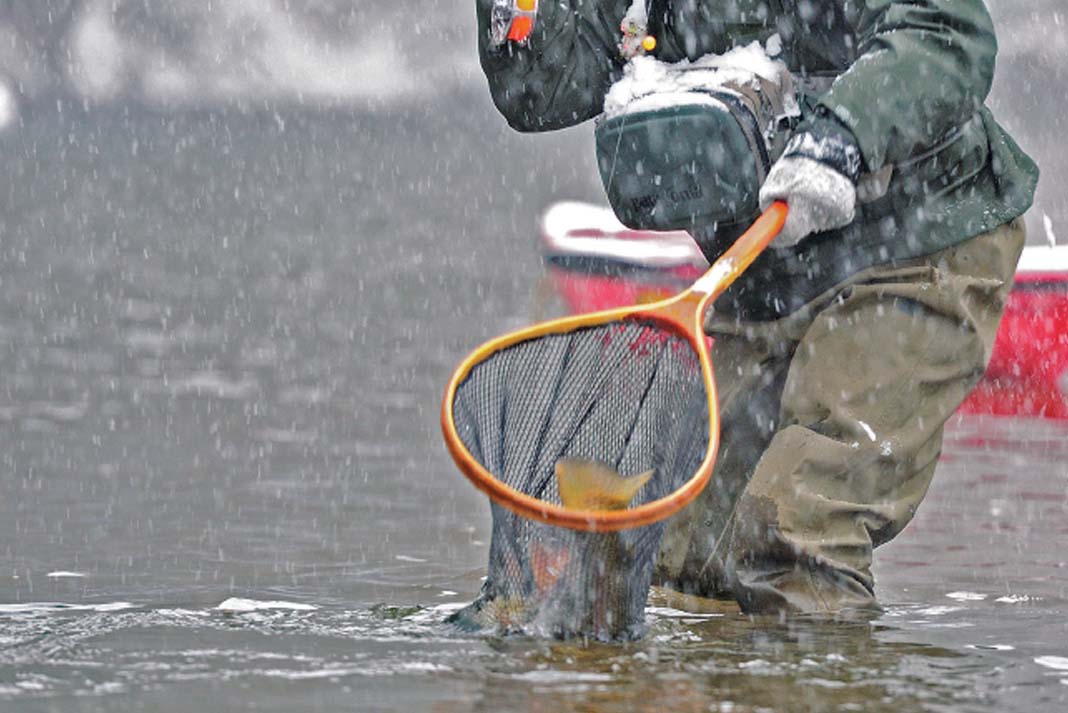Products You May Like
Just because it’s winter doesn’t mean you should pack away the kayak and take up knitting. Most anglers are a short drive from a river or creek where moving water will stay ice-free for the winter. Species like trout, largemouth and smallmouth bass are eager to eat in the off-season, making winter a great time of year to catch your best fish.
Fish Moving Water for a Year-Round Rush
According to Captain Kyle Fronrath of Fontana Guides in Bryson City, North Carolina, trout fishing during the cold months is a good way to get a big bite. “The two most important aspects of winter trout fishing are downsizing the lure and slowing the retrieve,” he says. That means using two- to four-pound fluorocarbon line for conventional anglers or a 5X to 6X tippet for fly fishermen.
When the water temperature drops, Fronrath fly fishes with nymphs, stoneflies and midges. For conventional gear, he sticks with small in-line spinners and suspending jerkbaits. He recommends targeting tailwaters where water from bottom-release dams stays warm most of the year. Trout are famous for being finicky and they get even more selective as cold temperatures slow their metabolism. But Fronrath adds, “Winter offers the best time to catch the biggest trout because you have the river all to yourself.”
“Winter offers the best time to catch the biggest trout because you have the river all to yourself.”
Learn what largemouth want
Largemouth bass love swift-moving water and they aren’t afraid of the cold. Malibu Kayaks pro, Drew Haerer, fishes for Froggy Waters Outdoors guide service through the off-season. To fool a frosty bucketmouth, he suggests using a small jerkbait, lipless crankbait or spinnerbait. Before hitting the water, he keeps a close eye on river level gauges to make sure the current flow and water level are safe. Haerer searches the river until he finds a deep hole with slow current.
“When I find a good spot, I will thoroughly fish the area by varying the speed of my retrieve and changing lures,” he explains. Once he finds bass biting, Haerer experiments with larger lures like a half-ounce jig or a five-inch hollow-belly swimbait to trick larger bass. “The key is having patience to let the fish tell you what lure and presentation they want.”
“When I find a good spot, I will thoroughly fish the area by varying the speed of my retrieve and changing lures,”
Smaller baits for smallmouth bass
Smallmouth bass are also famous cold water adversaries. For Matt Frazier of Living Water Outfitters in King’s Mountain, North Carolina, water temperature determines the tactic he uses. “When the water temp is still in the 50s, I rely on small crankbaits and squarebills that slow roll off the rocks and boulders,” he says. After the deep freeze drops water below 50 degrees, he switches to a suspending jerkbait that will hang motionless in the water column.
All three anglers agree, once you unlock the secrets of winter fishing on your favorite river, you can return to the same spot with the same tactic and score frozen fish sticks all winter long.
The weather might be frightful, but moving waters and hungry fish make winter fishing delightful. | Feature photo: Barry Beck
